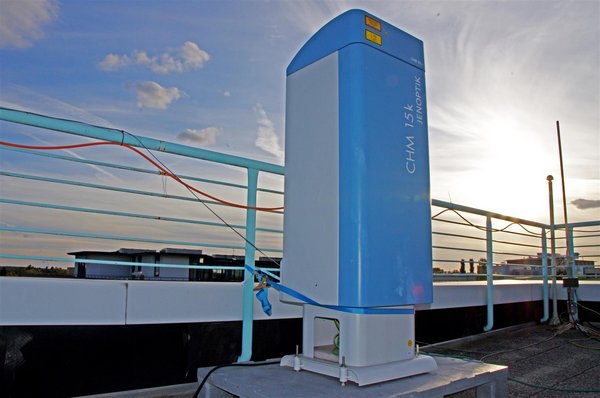Ceilometer
Motivation
Ceilometers are simple but robust lidar systems. Normally laser pulses are generated of one wavelength. Their backscattered energy from the atmosphere is temporarily resolved. Originally, ceilometers are used for the detection of the cloud base height but they can also serve for determination of aerosol properties. Beside PollyXT, the ceilometer is a central part of LACROS and Cloudnet to receive continuous information about the height of cloud and aerosol layers. On one hand this information is used for aerosol studies, on the other hand it id needed for the investigation of aerosol-cloud interaction.
Figure 1 shows a ceilometer of the type CHM-15k of Jenoptik company as it is operated at TROPOS.
Properties of the Jenoptik CHM-15k
Technical specifications:
- Accuracy: ± 5m (± 16 ft)
- Measuring principle: Optical LIDAR (solid state laser source) Laser Class 1M
- Measuring range: 5 m - 15 km (16 ft ... 50,000 ft)
- Resolution of backscatter data: Standard: 15 m (50 ft)Optional: 5 m (16 ft)
- Hardware resolution: 200 MHz sampling rateQuantities to be measured:
Provided Parameters:
- Cloud base (max. 5 layers, preset: 3 layers)
- Cloud amount
- Penetration depth
- Vertical visibility
- Height of mixing layer
Application at TROPOS
At TROPOS, the ceilometer is used in the following applications:
- In the framework of Cloudnet, to provide a continous determination of the vertical cloud distribution and of microphysical cloud properties.
- In the framework of combined lidar-sun-photometer techniques to retrieve vertical profiles of the aerosol backscatter coefficient during daytime.
- To estimate boundary-layer and mixing-layer heights to aid the interpretation of ground-based in-situ aerosol measurements.
- During field experiments of ACTOS to assist planning of flights.

